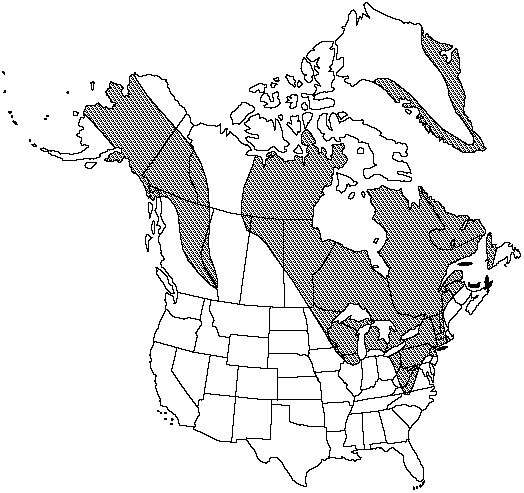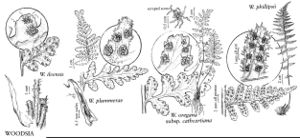Difference between revisions of "Woodsia ilvensis"
Trans. Linn. Soc. London, Bot. 11: 173. 1813.
FNA>Volume Importer |
GeoffLevin (talk | contribs) m (Fixed Nfld. and Labr. distribution to match printed version.) |
||
| (3 intermediate revisions by 2 users not shown) | |||
| Line 8: | Line 8: | ||
}} | }} | ||
|common_names=Rusty cliff fern;woodsie de l'île d'Elbe | |common_names=Rusty cliff fern;woodsie de l'île d'Elbe | ||
| + | |special_status={{Treatment/ID/Special_status | ||
| + | |code=F | ||
| + | |label=Illustrated | ||
| + | }} | ||
|basionyms={{Treatment/ID/Basionym | |basionyms={{Treatment/ID/Basionym | ||
|name=Acrostichum ilvense | |name=Acrostichum ilvense | ||
| Line 29: | Line 33: | ||
|habitat=Cliffs and rocky slopes, found on variety of substrates including serpentine | |habitat=Cliffs and rocky slopes, found on variety of substrates including serpentine | ||
|elevation=0–1500 m | |elevation=0–1500 m | ||
| − | |distribution=Greenland;Alta.;B.C.;Man.;N.B.;Nfld.;N.W.T.;N.S.;Ont.;Que.;Sask.;Yukon;Alaska;Conn.;Ill.;Iowa;Maine;Md.;Mass.;Mich.;Minn.;N.H.;N.J.;N.Y.;N.C.;Ohio;Pa.;R.I.;Vt.;Va.;W.Va.;Wis.;n Eurasia. | + | |distribution=Greenland;Alta.;B.C.;Man.;N.B.;Nfld. and Labr.;N.W.T.;N.S.;Nunavut;Ont.;Que.;Sask.;Yukon;Alaska;Conn.;Ill.;Iowa;Maine;Md.;Mass.;Mich.;Minn.;N.H.;N.J.;N.Y.;N.C.;Ohio;Pa.;R.I.;Vt.;Va.;W.Va.;Wis.;n Eurasia. |
|discussion=<p>Although generally separable by the characters given in the key, shade forms of <i>Woodsia ilvensis</i> with a reduced number of scales and hairs are occasionally misidentified as <i>W. alpina</i>. The morphologic distinctions between these species are further blurred by natural hybridization, which produces the intermediate triploid known as W. × gracilis. Some of the best characters for distinguishing these taxa are spore size and morphology. Spores average less than 46 µm in <i>W. ilvensis</i>, more than 46 µm in <i>W. alpina</i>, and are malformed and abortive in W. × gracilis. <i>Woodsia ilvensis</i> also hybridizes with <i>W. oregana </i>subsp.<i> cathcartiana</i> to form the sterile triploid W. × abbeae (F. S. Wagner 1987).</p> | |discussion=<p>Although generally separable by the characters given in the key, shade forms of <i>Woodsia ilvensis</i> with a reduced number of scales and hairs are occasionally misidentified as <i>W. alpina</i>. The morphologic distinctions between these species are further blurred by natural hybridization, which produces the intermediate triploid known as W. × gracilis. Some of the best characters for distinguishing these taxa are spore size and morphology. Spores average less than 46 µm in <i>W. ilvensis</i>, more than 46 µm in <i>W. alpina</i>, and are malformed and abortive in W. × gracilis. <i>Woodsia ilvensis</i> also hybridizes with <i>W. oregana </i>subsp.<i> cathcartiana</i> to form the sterile triploid W. × abbeae (F. S. Wagner 1987).</p> | ||
|tables= | |tables= | ||
| Line 48: | Line 52: | ||
|habitat=Cliffs and rocky slopes, found on variety of substrates including serpentine | |habitat=Cliffs and rocky slopes, found on variety of substrates including serpentine | ||
|elevation=0–1500 m | |elevation=0–1500 m | ||
| − | |distribution=Greenland;Alta.;B.C.;Man.;N.B.;Nfld.;N.W.T.;N.S.;Ont.;Que.;Sask.;Yukon;Alaska;Conn.;Ill.;Iowa;Maine;Md.;Mass.;Mich.;Minn.;N.H.;N.J.;N.Y.;N.C.;Ohio;Pa.;R.I.;Vt.;Va.;W.Va.;Wis.;n Eurasia. | + | |distribution=Greenland;Alta.;B.C.;Man.;N.B.;Nfld. and Labr.;N.W.T.;N.S.;Nunavut;Ont.;Que.;Sask.;Yukon;Alaska;Conn.;Ill.;Iowa;Maine;Md.;Mass.;Mich.;Minn.;N.H.;N.J.;N.Y.;N.C.;Ohio;Pa.;R.I.;Vt.;Va.;W.Va.;Wis.;n Eurasia. |
|reference=None | |reference=None | ||
|publication title=Trans. Linn. Soc. London, Bot. | |publication title=Trans. Linn. Soc. London, Bot. | ||
|publication year=1813 | |publication year=1813 | ||
| − | |special status= | + | |special status=Illustrated |
| − | |source xml=https:// | + | |source xml=https://bitbucket.org/aafc-mbb/fna-data-curation/src/2e0870ddd59836b60bcf96646a41e87ea5a5943a/coarse_grained_fna_xml/V2/V2_349.xml |
|genus=Woodsia | |genus=Woodsia | ||
|species=Woodsia ilvensis | |species=Woodsia ilvensis | ||
Latest revision as of 21:41, 20 February 2024
Stems compact, erect to ascending, with abundant persistent petiole bases of ± equal length; scales uniformly brown, lanceolate. Leaves 4.5–25 × 1.2–3.5 cm. Petiole usually brown or dark purple when mature, articulate above base at swollen node, relatively brittle and easily shattered. Blade narrowly lanceolate, usually 2-pinnate proximally, lacking glands, never viscid; rachis usually with abundant hairs and scales. Pinnae ovate-lanceolate to deltate, longer than wide, abruptly tapered to a rounded or broadly acute apex; largest pinnae with 4–9 pairs of pinnules; abaxial surface with mixture of hairs and linear-lanceolate scales, adaxial surface with multicellular hairs concentrated along midrib. Pinnules entire or crenate, rarely shallowly lobed; margins nonlustrous, thin, ciliate with multicellular hairs, lacking translucent projections. Vein tips frequently enlarged to form whitish hydathodes visible adaxially. Indusia of narrow, hairlike segments, these uniseriate throughout, composed of cells many times longer than wide, usually surpassing mature sporangia. Spores averaging 39–46 µm. 2n = 82.
Phenology: Sporulating summer–early fall.
Habitat: Cliffs and rocky slopes, found on variety of substrates including serpentine
Elevation: 0–1500 m
Distribution

Greenland, Alta., B.C., Man., N.B., Nfld. and Labr., N.W.T., N.S., Nunavut, Ont., Que., Sask., Yukon, Alaska, Conn., Ill., Iowa, Maine, Md., Mass., Mich., Minn., N.H., N.J., N.Y., N.C., Ohio, Pa., R.I., Vt., Va., W.Va., Wis., n Eurasia.
Discussion
Although generally separable by the characters given in the key, shade forms of Woodsia ilvensis with a reduced number of scales and hairs are occasionally misidentified as W. alpina. The morphologic distinctions between these species are further blurred by natural hybridization, which produces the intermediate triploid known as W. × gracilis. Some of the best characters for distinguishing these taxa are spore size and morphology. Spores average less than 46 µm in W. ilvensis, more than 46 µm in W. alpina, and are malformed and abortive in W. × gracilis. Woodsia ilvensis also hybridizes with W. oregana subsp. cathcartiana to form the sterile triploid W. × abbeae (F. S. Wagner 1987).
Selected References
None.
